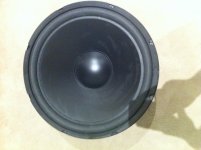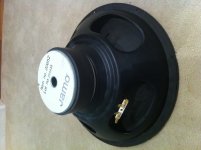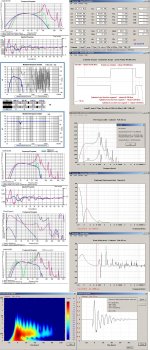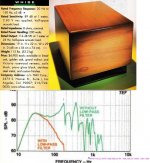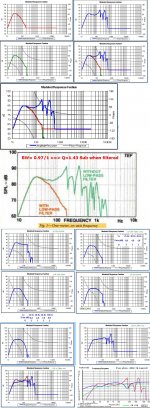Hi fury,
Looks like bjorno's T-TQWT would fit into your design dimension with the only problem dimension being the 450mm (17.717") which might be a problem with the driver size. Can you provide the driver dimensions, e.g.: a simple dimensioned sketch would do. From that we could take a look at what it would take to fold this one.
Regards,
Looks like bjorno's T-TQWT would fit into your design dimension with the only problem dimension being the 450mm (17.717") which might be a problem with the driver size. Can you provide the driver dimensions, e.g.: a simple dimensioned sketch would do. From that we could take a look at what it would take to fold this one.
Regards,
It's been a while since I've built a TL, or simulated or measured one. Although very recently I've built a tapped horn, and when looking at it one starts to think there are some similar things going on. The first though occuring to many on seeing a tapped horn might be "that looks like a TL!"
Regarding localisation, I found from measurements that two sub positions in my room had promise - coffee table position in front of couch and a position in the left rear corner, not far from where I sit. In both cases it was a simple sealed box with a Rythmik servo sub, one that I would expect to perform well in terms of localisation for a couple of reasons. One, the crossover allows for a 4th order low pass if desired, two, they are very clean with very low distortion especially above 40 Hz, the range that matters most for music.
The peaks seen in a TL may be sufficiently damped, so they may not be a major concern, but they certainly can't help with localisation.
I found despite a low crossover and added filtering with DCX that those positions could not be made to work for reasons of interfering with imaging. Now I suppose if you could get a TL and sufficiently damp all the peaks and then end up with sufficiently lower harmonic distortion compared to a sealed or vented box, then perhaps you are then improving the localisation issue.
Bandpass subs have a reputation that is less than deserved. There was a company that started bringing them back to the Australian market - Whise. They introduced what were essentially bandpass subs, but the market seemed to reject the size. They were a commercial sub much more like a DIY sub! A well regarded local designer who has recently passed away (Colin Whatmough) took up the technology and started making his own. I heard one of his and it was indeed very good. I suspect the best of all subs regarding localisation is in fact a bandpass that uses passive radiators in place of ports. Or perhaps a Geddes acoustic lever in which PRs are inherent to the design.
One should not dismiss bandpass too readily, as many make the mistake of doing. The Synergy horn basically applies the same concept into the midrange! In effect it uses horn loaded 4th order bandpass mids, and I believe the acoustic filtering is a significant part of the magic of the Synergy horn sound where mids that are nothing special on their own create an ultra clean midrange in a range where our ears are far more resolving.
Regarding localisation, I found from measurements that two sub positions in my room had promise - coffee table position in front of couch and a position in the left rear corner, not far from where I sit. In both cases it was a simple sealed box with a Rythmik servo sub, one that I would expect to perform well in terms of localisation for a couple of reasons. One, the crossover allows for a 4th order low pass if desired, two, they are very clean with very low distortion especially above 40 Hz, the range that matters most for music.
The peaks seen in a TL may be sufficiently damped, so they may not be a major concern, but they certainly can't help with localisation.
I found despite a low crossover and added filtering with DCX that those positions could not be made to work for reasons of interfering with imaging. Now I suppose if you could get a TL and sufficiently damp all the peaks and then end up with sufficiently lower harmonic distortion compared to a sealed or vented box, then perhaps you are then improving the localisation issue.
Bandpass subs have a reputation that is less than deserved. There was a company that started bringing them back to the Australian market - Whise. They introduced what were essentially bandpass subs, but the market seemed to reject the size. They were a commercial sub much more like a DIY sub! A well regarded local designer who has recently passed away (Colin Whatmough) took up the technology and started making his own. I heard one of his and it was indeed very good. I suspect the best of all subs regarding localisation is in fact a bandpass that uses passive radiators in place of ports. Or perhaps a Geddes acoustic lever in which PRs are inherent to the design.
One should not dismiss bandpass too readily, as many make the mistake of doing. The Synergy horn basically applies the same concept into the midrange! In effect it uses horn loaded 4th order bandpass mids, and I believe the acoustic filtering is a significant part of the magic of the Synergy horn sound where mids that are nothing special on their own create an ultra clean midrange in a range where our ears are far more resolving.
Hi fury,
Looks like bjorno's T-TQWT would fit into your design dimension with the only problem dimension being the 450mm (17.717") which might be a problem with the driver size. Can you provide the driver dimensions, e.g.: a simple dimensioned sketch would do. From that we could take a look at what it would take to fold this one.
Regards,
Thank you very much guys for all your assistance!
The dimensions of the sub are:
385mm diameter
180mm mounting depth + 15mm total height
145mm diameter magnet
Hope this helps 🙂
As note, I will be using a DCX with this, so signal processing is not a problem.
Last edited:
Hi fury,
Forgot to ask: what is the mounting hole diameter, and what is the bolt circle diameter? Could you post a picture of the driver side/back view? Well, back to work.
Regards,
Forgot to ask: what is the mounting hole diameter, and what is the bolt circle diameter? Could you post a picture of the driver side/back view? Well, back to work.
Regards,
Sorry for the delay in getting back to you.
Has been a hectic week for me.
Attached are some images of the sub.
I did measure the mounting hole diameter but I can't for the life of me remember... It was either 380mm or 375mm.
Has been a hectic week for me.
Attached are some images of the sub.
I did measure the mounting hole diameter but I can't for the life of me remember... It was either 380mm or 375mm.
Attachments
Hi fury,
I've been crazy busy too, and it doesn't look like there'll be a lot of slack in the oil and gas sector this year.
Anyway, the mounting hole has to be closer to 355mm. I'll try to post some general ideas on a layout later tonight.
Regards,
I've been crazy busy too, and it doesn't look like there'll be a lot of slack in the oil and gas sector this year.
Anyway, the mounting hole has to be closer to 355mm. I'll try to post some general ideas on a layout later tonight.
Regards,
Hi fury,
Here is my first try at folding an isobaric dual 15" driver T-TQWT into your dimensions. It's not a complete drawing, and if you decide you want to build this I can add the other dimensions, etc. At least this gives you something to look at.
Regards,
Here is my first try at folding an isobaric dual 15" driver T-TQWT into your dimensions. It's not a complete drawing, and if you decide you want to build this I can add the other dimensions, etc. At least this gives you something to look at.
Regards,
Attachments
Thanks a lot Oliver.
I'll have a look at it in HornResp when I get a moment.
I'm guessing trying to fit all 4 woofers into this coffee table might not work? 😛
In your drawing, the opening is at the end of the line, at S1 yes? So it opens up facing down?
These boxes will be raised off the floor around 5cm (maybe more if necessary). The distance between the floor and the box would have an effect on line length and tuning i'd imagine? Anyway to add this into the equation, or is it not worth considering?
I'll have a look at it in HornResp when I get a moment.
I'm guessing trying to fit all 4 woofers into this coffee table might not work? 😛
In your drawing, the opening is at the end of the line, at S1 yes? So it opens up facing down?
These boxes will be raised off the floor around 5cm (maybe more if necessary). The distance between the floor and the box would have an effect on line length and tuning i'd imagine? Anyway to add this into the equation, or is it not worth considering?
Hi fury,
This is bjorno's T-TQWT, the closed end is at S4, the opening (terminus) is S1. As to the number of woofers, you'll have to left over for sealed sub endtables 🙂.
Regards,
This is bjorno's T-TQWT, the closed end is at S4, the opening (terminus) is S1. As to the number of woofers, you'll have to left over for sealed sub endtables 🙂.
Regards,
Last edited:
Classic BP>=4 order better than a T-TQWT
FYI:
If anyone believe that a BP would be a design that brings SQ ... when using your drivers: Have a look at whats IMO required:
The first of Pictures = IMO a flawed design if not adding an EQ.
...and if still are in despair over larger box sizes:
The second + Third of pictures: A 199L,$ 4900 Commercial ' one-note quality' severely overrated scrutinized design to compare with:
The forth of submitted pictures using 2 Jamo drivers in isobaric series that if EQ +HPF and LPF: IMO still cannot compete with SQ to a stuffed T_TQWT if using the same drivers.
b🙂
FYI:
If anyone believe that a BP would be a design that brings SQ ... when using your drivers: Have a look at whats IMO required:
The first of Pictures = IMO a flawed design if not adding an EQ.
...and if still are in despair over larger box sizes:
The second + Third of pictures: A 199L,$ 4900 Commercial ' one-note quality' severely overrated scrutinized design to compare with:
The forth of submitted pictures using 2 Jamo drivers in isobaric series that if EQ +HPF and LPF: IMO still cannot compete with SQ to a stuffed T_TQWT if using the same drivers.
b🙂
Attachments
- Status
- Not open for further replies.
- Home
- Loudspeakers
- Subwoofers
- What to do with these drivers?
